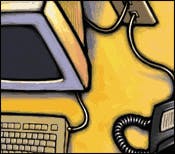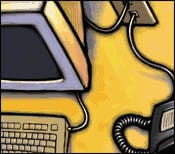Several hurdles, and perhaps several more years, separate the promise and reality of standardized fiber-to-the-desk products.
We have just concluded a major market analysis of the high-performance structured cabling market, seeking in part to answer the question, "Will fiber-to-the-desk become a reality soon?" Our analysis included Category 5, 5e, and 6 shipment forecasts for cables and apparatus devices over the next five years, as well as future Category 7 cabling.
For the past 10 years, if not longer, fiber-to-the-desk has been the Holy Grail sought by fiber cabling suppliers. Many false starts have occurred because suppliers believed their new fiber-to-the-desk systems would offer higher performance along with an economical and easy to use solution as existing unshielded twisted-pair (UTP) cabling systems. But every time that fiber-to-the-desk seemed to be about to gain a foothold, a development in UTP cabling encroached.
For example, early on, 10 Mbits/sec was the limit for UTP cabling. Higher transmission speeds would need fiber. Along came Category 5 cabling to support transmission speeds up to 100 Mbits/sec, thereby delaying the need for fiber cabling in these applications. If Category 5 UTP cabling in existing installations could not support 100 Mbits/sec, the TIA resolved this issue by creating the Category 5e UTP standard for new installations. Catetory 5e sounded the death knell for fiber usage at 100 Mbits/sec, and now Category 6 cabling will extend the bandwidth to 200 MHz.
When will this extending of UTP stop and force the need for fiber cabling? The answer is that the TIA has publicly stated that Category 6, when specified in the near future, will be the ultimate UTP cabling system, capable of being used in horizontal links of up to 100 meters supporting 200 MHz. Any performance beyond Category 6 will need fiber cabling.
The TIA has not yet started any study on a Category 7 cable. The ISO international standards body is in the process of releasing an equivalent Category 7 cable standard, Level F, which is specified to 600 MHz-or three times the performance of Category 6. International Organization for Standardization (ISO-www.iso.ch) is defining this cabling system as a shielded twisted-pair (STP) solution. Unlike the U.S. market, the international market-especially European countries-are primarily using STP cabling due to government-run post, telephone, and telegraph's (PTT) strict adherence to limiting electrical emissions from communications cabling inside buildings.
The hurdles ahead
In our assessment of future cabling needs, we do not believe that the U.S. market will accept a Category 7 STP cabling system. Although there is a major effort to harmonize the TIA and ISO cabling standards, it is believed that this is one area where the cabling standards will be different.
Early use of shielded cabling systems (i.e., IBM) were viewed as difficult to install and posed many problems. One of the most significant problems was maintaining a continuous ground on the cable shield without introducing any ground loops.
Another issue with STP cabling is the potential cable size and installation manageability. Current Category 7 (Level F) cables offered by companies such as Alcatel are bulky, with a 3/8-inch diameter, which are difficult to bend. For these and other reasons discussed in this article, it is believed that the TIA will specify fiber cabling as the preferred media for Category 7.
Based on the TIA's past performance in their standards release activities, it is likely that the earliest a Category 7 standard based on fiber will be released is 2004. Therefore, we estimate the first significant shipments of Category 7 fiber-to-the-desk cabling systems will be in 2005.
We believe there will be fiber-to-the-desk pre-standard Category 7 shipments happening earlier, but these will be minimal, as the expensive, permanent fiber-to-the-desk solution will await the release of the standards. This situation will be unlike the availability of UTP Category 5e or Category 6 cable products prior to the release of their standards.
The availability of a fiber-to-the-desk solution will be fortuitous, because at about the same time, it is expected that broadband application support at the desktop will be required, including 10-Gigabit Ethernet.
The release of the Institute of Electrical and Electronics Engineers (IEEE-www.ieee.org) 10-Gigabit standard is expected shortly. The first application is anticipated for aggregating 1-Gbit/sec horizontal floor traffic onto a 10-Gbit/sec fiber riser cabling subsystem. Like the other new higher bandwidth advances, 10-Gigabit Ethernet will migrate from the riser cabling subsystem to the horizontal cabling subsystem. This will be the genesis of fiber-to-the-desk, with fiber cabling being the only cable media able to support this high transmission speed of 10-Gbits/sec over 100 meters.
UTP cabling cannot go much above supporting 1-Gbit/sec over a 100 meter distance. The TIA will define Category 6 as the ultimate UTP cabling system.
Other reasons for fiber-to-the-desk's pending arrival:
- Fiber components are not only becoming cheaper but also user-friendly. Small-form-factor fiber connectors, which have the look and feel of a UTP RJ 8-pin modular telephone connector, are a case in point.
- The use of fiber cabling in the horizontal system is a natural evolution of expanding fiber's current use in the riser. An extension of the current centralized fiber architecture can be expanded to include fiber-to-the-desk.
Future fiber-to-the-desk architecture
We believe fiber-to-the-desk will incorporate a dual-core, singlemode, fiber cable, which will be easy to install, using dual, small-form-factor fiber connectors. The cabling architecture will be all-fiber, with fiber in the riser supporting fiber in the horizontal. We expect a Category 7 riser fiber cable to be part of the Category 7 standard. The current standard-based, centralized fiber architecture would lend itself to incorporate fiber-to-the-desk.
The all-fiber architecture offers not only an economical solution, but one that's reliable. With the removal of copper to fiber transitions, fiber transceivers are eliminated, which does away with these additional points of failure in the cabling system.
Details on this evolution to Category 7 fiber-to-the-desk, in conjunction with the evolutions of Cat 5e and Cat 6 UTP cabling systems, can be found in FTM Consulting's recently released report High Performance Structured Cabling Systems. For more information, call (717) 533-4990.
Frank Murawskiis president of FTM Consulting in Hummelstown, PA. His firm specializes in the analysis of the structured cabling system market.
Fiber-to-the-desk's impact on UTP
In our analysis of the high-performance structured cabling system marketplace, and the role that fiber-to-the-desk will play, we have reached several essential conclusions:
- The initial uptake of fiber-to-the-desk will be limited, primarily due to the user's familiarity with UTP cabling for the past 15 years, hindering the acceptance of a totally different cabling media type.
- 10-Gbits/sec at the desktop will be installed on a department-by-department basis rather than a totally new cabling install. The need for 10-Gbits/sec applications will initially be limited to the use for high-resolution, graphical displays for engineering, healthcare, or document creation needs. It would be too expensive in most instances to upgrade an entire cabling system from UTP to fiber all at one time.
- We have estimated the impact on UTP cabling in 2005 will be 2%, which is expected to increase to 4% by 2006.
- Post our forecast horizon of 2006, we expect fiber-to-the-desk to become prevalent at the larger enterprises after its initial introductory phase. Therefore, we believe a substantial impact on UTP cabling in the 2006-2011 time frame. This will be the first significant event to slow down UTP cabling use inside buildings.

